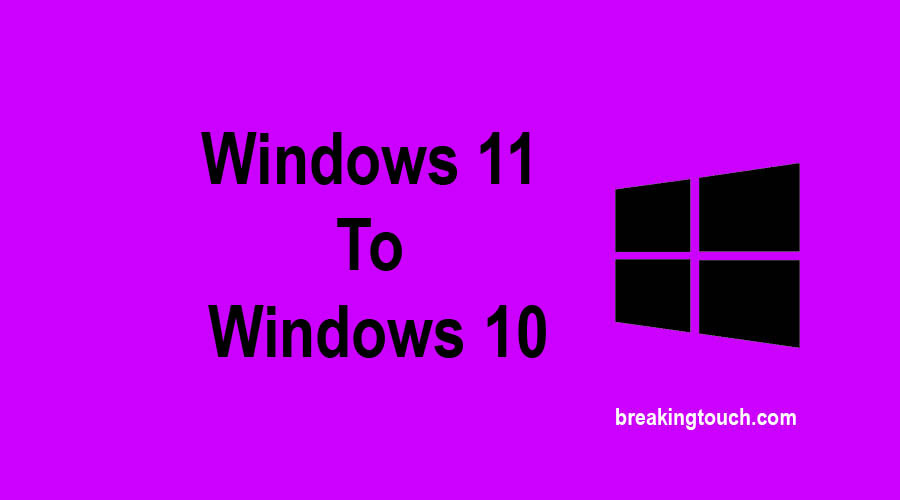Looking for how to downgrade Windows 11 to Windows 10? Or revert back to windows 10 from windows 11 then you are in the exact place now. Here you will get step by step guide about windows 11 back to windows 10. In this guide, we’ll show you how to switch from Windows 11 to Windows 10.
There really is a lot to love about Windows 11, but you can’t get around the fact that it won’t be to everyone’s liking. The fact that Microsoft has made it available as a free update for Windows 10 means that there is no risk in trying the latest version of the operating system (OS).
Downgrade Windows 11 to Windows 10
If you find that you just don’t like Windows 11, you might not like how it looks, or if you have some issues with hardware or software, for example, you’ll be happy that it’s possible to go back to Windows 10.
Here we are going to show you how to upgrade from Windows 11 to Windows 10.
Windows 11 Task Manager | How to Launch Task Manager in Windows 11
First steps
While Microsoft has made it possible to move from Windows 11 to Windows 10, in case you change your mind about the operating system for some reason, the important thing to remember is that this is an offer for a limited time. The method explained here to revert to Windows 10 is only available for ten days after the update.
It’s also worth noting that this method will only work if you’ve upgraded from Windows 10 to Windows 11. If you’ve purchased a computer with Windows 10 preinstalled, there’s no quick and easy way to downgrade.

Advanced options
If you’re in the Microsoft-allowed downgrade window and you’re sure you want to revert to Windows 10 after upgrading to Windows 11, here’s what you need to do.
First close all running applications, save open documents, then open Settings through the Start menu or simultaneously press Windows + I key. Go to the “Windows Update” section in the left list and click on the right area under “Advanced options”. Scroll down to the Additional Options section and click on Recovery.
Use the recovery options
Take a look at the Recovery Options section and you will see lots of options for data recovery, restarting your computer, and troubleshooting.
Click the “Back” button in the “Previous: If this version doesn’t work, try reverting to Windows 10”.
There will be a slight delay while Windows 11 does some background checks and prepares things for the restore process to begin in Windows 10. At this point, you will be notified if you are not in the 10 allowed. Period, and if you do, the process is canceled.
Report to Microsoft
You’ll be asked why you want to revert to Windows 10 from Windows 11. While you don’t have to be honest here, if you don’t, this is information that could help Microsoft do better in the future. , and that’s a good idea. Share your experience.
You cannot go back until you choose an answer, but you can select “Another reason” if you want and it’s up to you to provide further details or not. You can then click on the now available “Next” button to continue.
Windows 11 Not Compatible | How to Fix This PC Can’t Run Windows 11 Error
Check for updates
Microsoft will try to convince you to stick with Windows 11 by suggesting that you check for available updates.
The idea here is that if you’ve had any issues with Windows 11, installing the latest updates should fix them for you. If you’ve turned on automatic updates, you’ve probably installed all available updates anyway, but the choice is yours; You can click “Check for Updates” and give Windows 11 a second chance, or if you are determined to continue, click “No Thanks” to proceed with the restore.
Make sure you want to continue
Before you can proceed, Microsoft is pointing out a few things that it thinks you should know before you fully commit to the restoration. As the message that appears indicates, the process may take some time and your computer will be unavailable for some time. If you are using a laptop, you should make sure it is plugged in to avoid draining the battery during the process.
You should also be aware that some configuration changes you made during the update will be lost and you may need to reinstall some apps. Click “Next” if you agree to continue.
You will be reminded that you will need to know your Windows 10 user account password to log in and that you will need to click “Next” again to continue.
The last thing you need to do is hit the “Return to Windows 10” button and be prepared to wait for a while. Your computer will restart automatically and the Windows 11 uninstallation process will begin. It won’t be busy for a while, so you can let your computer do it for a while.
Restore the previous version of Windows
If you choose to be on your computer while reverting to Windows 10, you will see a message saying “Restore the previous version of Windows …” and the animation will warn you that something is happening in the background.
The length of this process depends on several factors including the size of your hard drive and the amount of data, but the speed of your hardware also plays a role.
Log into Windows 10
After a while, the Windows 10 login screen will appear where you can select your user account and enter your password or PIN.
As stated earlier, you will likely find that some of the settings you changed while running Windows 11 have been removed, and you may also need to spend some time reinstalling deleted apps or just stopping working. However, you should find that all your data has been saved, so you shouldn’t have lost any important files.
Go back to Windows 11
If you change your mind in the future and want to try Windows 11 again, you can. You can always go to Windows Update in the Settings app to start the update, or you can visit the Windows 11 section of Microsoft’s website.
From this page, you can download a Windows 11 ISO image, use the Windows 11 installation wizard, or use the Media Creation Tool to create an installation DVD or USB drive that you can use. when you are ready.






